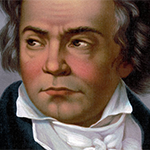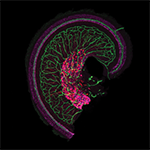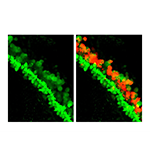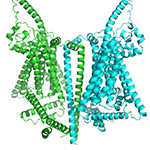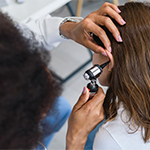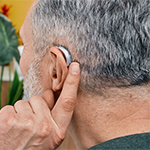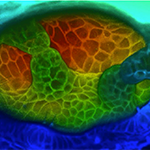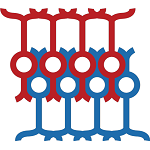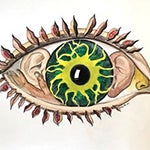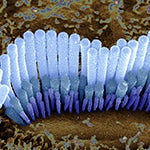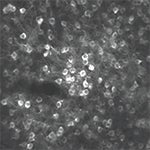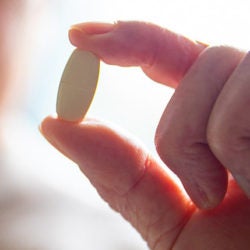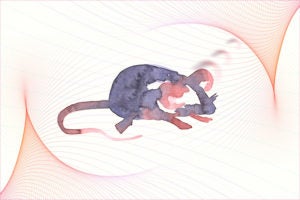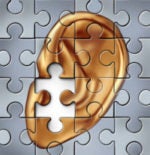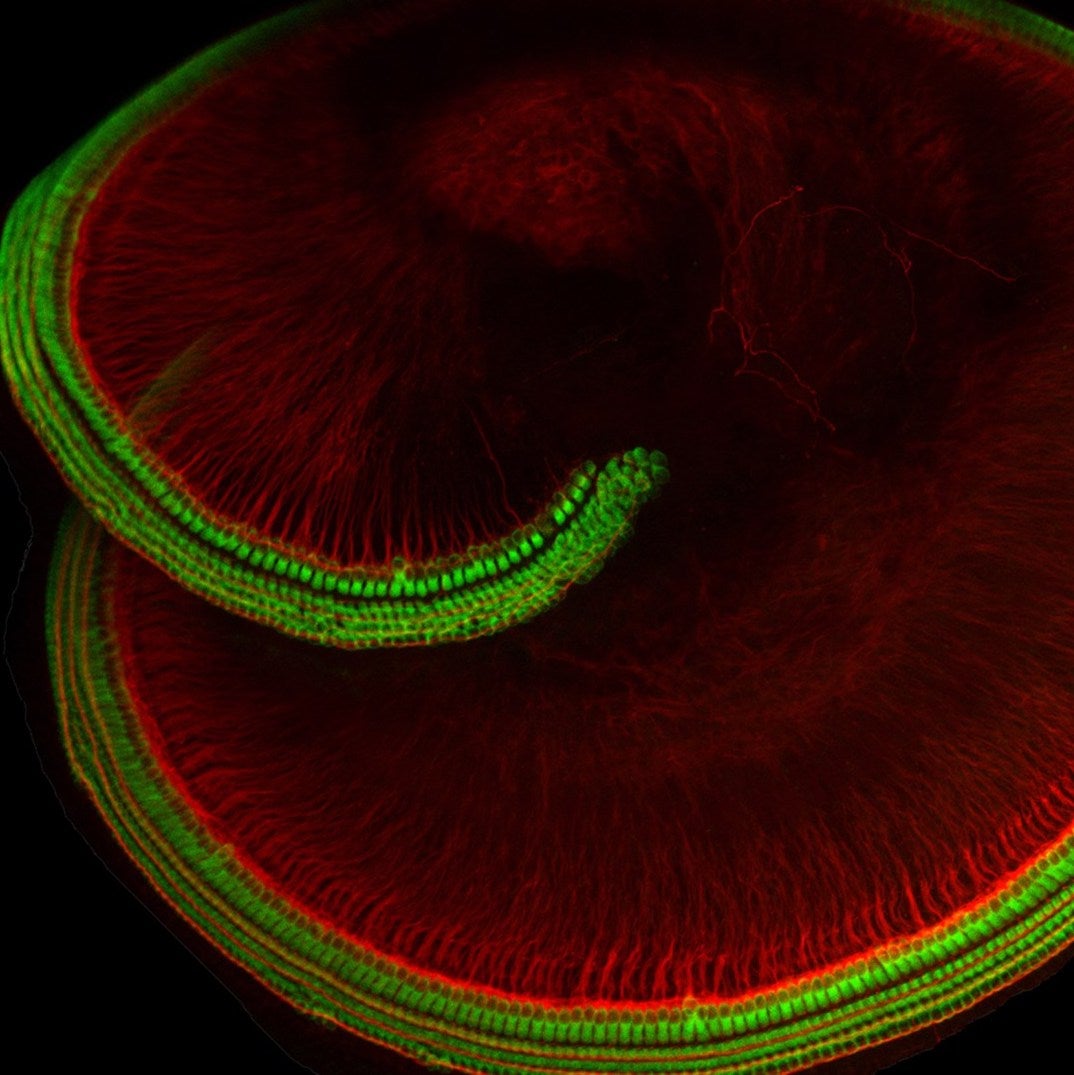Neuro Topics - Hearing
SEARCH OTHER RESEARCH AREAS
January 17, 2025
New research from David Ginty, David Corey, Lisa Goodrich, and colleagues, first author Erica Huey, may help explain why the sense of touch gets stronger and more precise after hearing loss.
Original article in: Cell >
February 8, 2024
A novel gene therapy approach has given five children who were born deaf the ability to hear. The method, which overcomes a roadblock presented by large genes, may be useful in other treatments, according to researchers.
Original article in: The Lancet >
April 25, 2023
Loss of the inner ear sensory cells, the hair cells, is considered one of the most common causes of hearing loss that is generally permanent. Using single-cell RNAseq, advanced imaging, electrophysiology, and lineage tracing, Yizhou Quan, Zheng-Yi Chen, and colleagues identified a cocktail of drug-like molecules that effectively reprograms fully mature wildtype supporting cells for hair cell regeneration, representing a step forward for hearing restoration by HC regeneration.
Original article in: PNAS >
Exploring the Molecular Dynamics of Hearing: Ion Channels That Convert Sound into Electrical Signals
October 5, 2022
Nurunisa Akyuz of the Corey lab describes a new study focused on the inner-ear mechanosensory channel, TMC1 (Transmembrane Channel Like 1). Structural modeling, mutagenesis, viral gene delivery and hair-cell physiology experiments were used to determine aspects of TMC1 gating.
Original article in: Science Advances >
September 20, 2022
HMS News article on new research from Matthew Crowson, Christopher Hartnick, and colleagues at HMS and Mass. Eye and Ear. They built an artificial intelligence model that they have shown to outperform clinicians in diagnosing pediatric ear infections.
Original article in: Otolaryngology–Head and Neck Surgery >
August 1, 2022
HMS News article profiling the research of Bruce Bean and Clifford Woolf, who are studying how CBD inhibits pain-sensing neurons in order to develop more effective pain medicines.
Original article in: Otolaryngology–Head and Neck Surgery >
August 1, 2022
Harvard Gazette article on new research from Samuel Mehr and colleagues, co-first authors Courtney Hilton and Cody J. Moser. They studied 21 cultures, from San Diego to East Africa and found striking similarities in infant-directed speech and song.
Original article in: Nature Human Behavior >
July 15, 2022
HMS News article on new research from Hadine Joffe and colleagues, first author Alexandra Z. Sosinsky, showing that females are underrepresented in key disease clinical trials, with the largest gap observed in psychiatric clinical trials.
Original article in: Contemporary Clinical Trials >
July 15, 2022
HMS News article on the development of a new word-score model from Stéphane Maison and colleagues, first author Kelsie J. Grant, which leads to better evaluations of cochlear nerve damage.
Original article in: Scientific Reports >
January 21, 2022
Round up of awards and honors earned by the HBI community.
Original article in: Scientific Reports >
January 21, 2022
HMS News article on a new discovery by Sean Megason and colleagues, first author Akankshi Munjal, of mechanical process by which sheets of cells morph into the delicate, looping semicircular canals of the inner ear.
Original article in: Cell >
January 18, 2022
The Tan-Yang Center seeks a Program Manager who will be responsible for planning scientific events and outreach activities, running a postdoctoral fellowship program, managing a website, newsletter, and social media, developing new community-building activities, and liaising with the related scientific and administrative units at Harvard University, as well as our sister Center at the McGovern Institute at MIT.
Original article in: Cell >
December 7, 2021
Aleena Garner, a new faculty member in the Department of Neurobiology at HMS, describes her latest research, together with Georg Keller of the Friedrich Miescher Institute for Biomedical Research, on how neural circuits between auditory and visual cortex communicate learned associations and create predictions. They show that experience with an audio-visual stimulus reshapes direct input from auditory cortex to visual cortex—suppressing predictable visual input to amplify the unpredictable.
Original article in: Nature Neuroscience >
November 12, 2021
HMS News article on new research from Albert Edge and colleagues, first author Yushi Hayashi, identifying the role of the protein behind rare Norrie disease.
Original article in: PNAS >
February 26, 2021
HMS News article on research from the labs of David Corey and Wesley Wong, first author Eric Mulhall, providing new insight into the functioning of the tip link—the tiny apparatus of hair cells in the ear that converts auditory signals into electrical ones.
Original article in: Nature Communications >
February 23, 2021
Congratulations to Masahito Yamagata, Isle Bastille, Kadir Ozkan, Carla Carol Winter, Ayush Noori, and Clara Muñoz-Castro
Original article in: Nature Communications >
January 5, 2021
Kameron Clayton shares new research from the lab of Daniel Polley. Using a combination of physiological and anatomical tools to access specific types of cortical neurons, they demonstrate that descending projection neurons in mouse auditory cortex are active prior to movements that are expected to generate sound.
Original article in: Current Biology >
September 8, 2020
Gwenaelle Geleoc shares her lab's new research into improving hearing and balance in mice. They targeted an Acadian human mutation in a gene essential for hearing and vision using local applications of antisense oligonucleotides.
Original article in: Molecular Theory >
July 28, 2020
HMS News article on new research from the lab of M. Charles Liberman, first author Pei-zhe Wu, on a new study that uncovers damage to hair cells as an underlying cause of age-related hearing loss.
Original article in: Journal of Neuroscience >
July 28, 2020
HMS News article on new research from the labs of Konstantina Stankovic and Albert Edge, first authors Richard Seist and Mingjie Tong, suggesting that bone disease medications may reverse hearing loss.
Original article in: Frontiers in Molecular Neuroscience >
July 1, 2020
BCH Discoveries article on new research from the labs of Jeffrey Holt, David Liu, and colleagues at the Broad and MIT, co-first authors Wei-Hsi Yeh and Olga Shubina-Oleinik, restoring hearing in deaf mice using a new genetic engineering technique.
Original article in: Science Translational Medicine >
December 19, 2019
HMS News article on new research from the lab of Zheng Yi-Chen, joint first authors Yilai Shu, Wenyan Li, Mingqian Huang, and Yi-Zhou Quan, introducing a new strategy to reprogram and regenerate inner-ear cells.
Original article in: Nature Communications >
September 6, 2019
HMS News article on new research from the lab of Stéphane Maison suggesting that chronic conductive hearing loss may interfere with speech recognition deficits.
Original article in: Nature Communications >
July 3, 2019
HMS News article on new research from the labs of David Corey, Jeffrey Holt and Gwenaëlle Géléoc. They used a newly optimized gene-editing tool to prevent hearing loss in mice with hereditary deafness without detectable off-target effects.
Original article in: Nature Medicine >
August 27, 2018
Harvard Gazette story on new work from the labs of Jeffrey Holt, David Corey and colleagues, revealing identity of a sensor protein that helps inner ear hair cells translate sound and head movements into electrical signals that the brain can process
Original article in: Neuron >
August 21, 2018
Ana Pereira and Yun Zhang describe a new project that was recently awarded funding from the Dean's Competitive Fund for Promising Scholarship
Original article in: Neuron >
August 13, 2018
HMS News article highlighting new work on sensory neuron diversity in the inner ear, from the labs of Lisa Goodrich and Charles Liberman at Harvard Medical School and Massachusetts Eye and Ear
Original article in: Cell >
July 17, 2018
An eLife press release on new work from the labs of Yun Zhang and Joshua Kaplan, exploring how C. elegans sense and avoid nitric oxide in their environments
Original article in: eLife >

